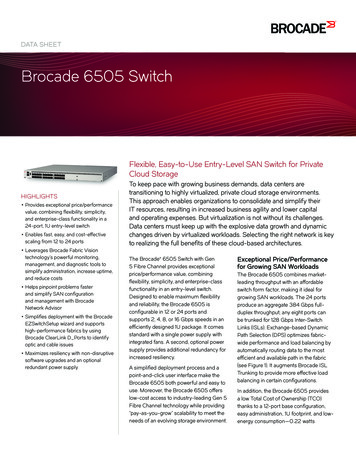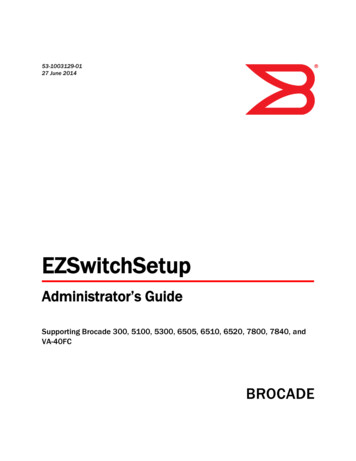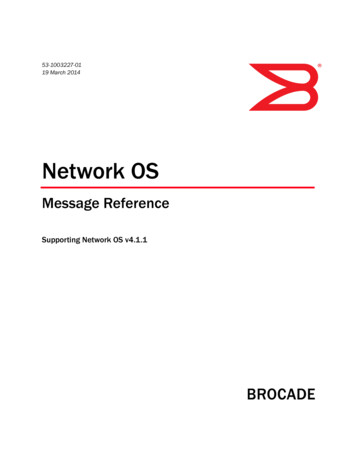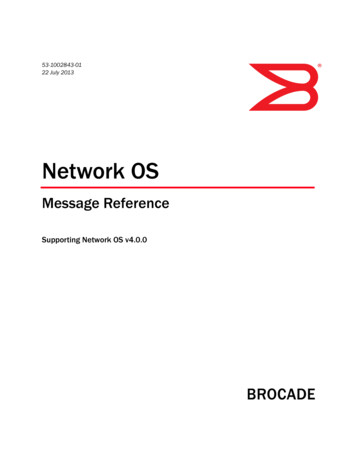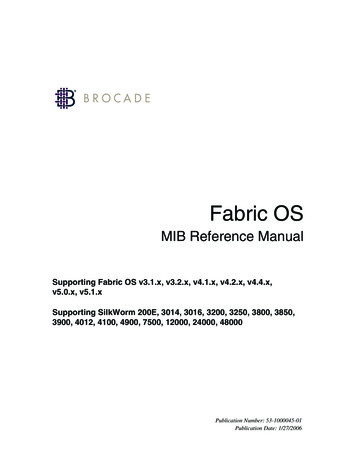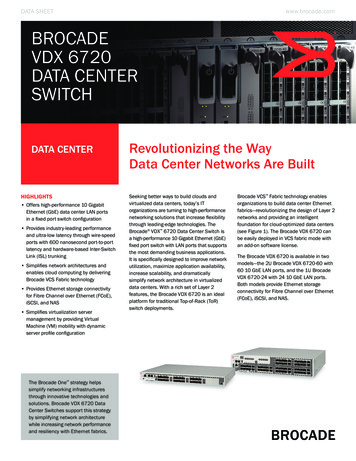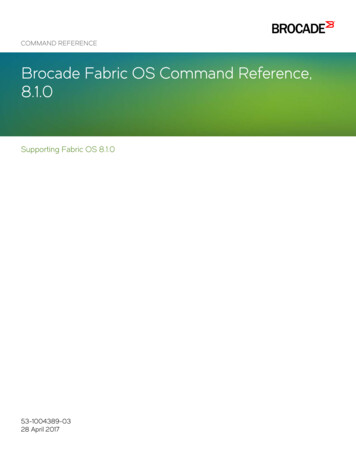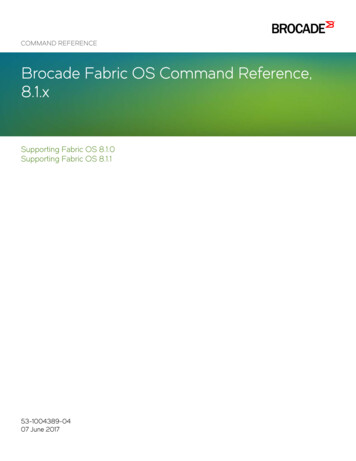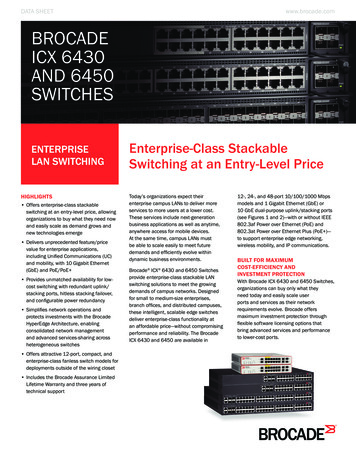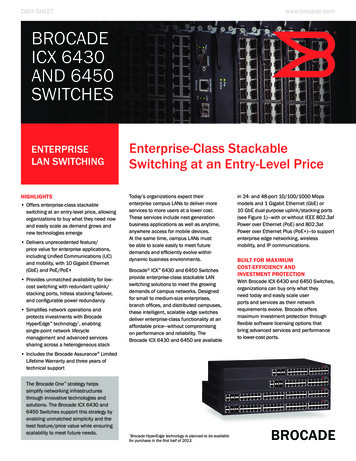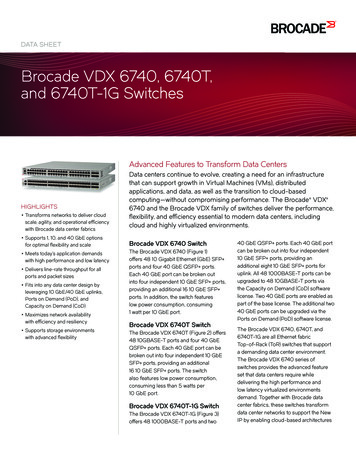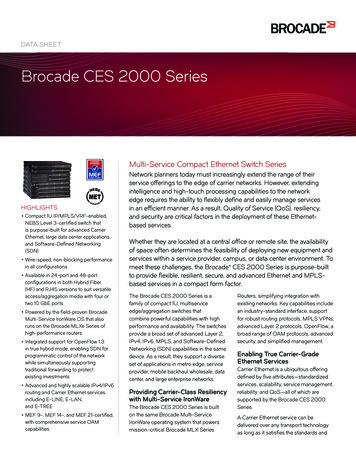
Transcription
DATA SHEETBrocade CES 2000 SeriesMulti-Service Compact Ethernet Switch SeriesBNE SHIGHLIGHTSCER T I FI E D Compact 1U IP/MPLS/VRF-enabled,NEBS Level 3-certified switch thatis purpose-built for advanced CarrierEthernet, large data center applications,and Software-Defined Networking(SDN) Wire-speed, non-blocking performancein all configurations Available in 24-port and 48-portconfigurations in both Hybrid Fiber(HF) and RJ45 versions to suit versatileaccess/aggregation media with four ortwo 10 GbE ports Powered by the field-proven BrocadeMulti-Service IronWare OS that alsoruns on the Brocade MLXe Series ofhigh-performance routers Integrated support for OpenFlow 1.3in true hybrid mode, enabling SDN forprogrammatic control of the networkwhile simultaneously supportingtraditional forwarding to protectexisting investments Advanced and highly scalable IPv4/IPv6routing and Carrier Ethernet services,including E-LINE, E-LAN,and E-TREE MEF 9-, MEF 14-, and MEF 21-certified,with comprehensive service OAMcapabilitiesNetwork planners today must increasingly extend the range of theirservice offerings to the edge of carrier networks. However, extendingintelligence and high-touch processing capabilities to the networkedge requires the ability to flexibly define and easily manage servicesin an efficient manner. As a result, Quality of Service (QoS), resiliency,and security are critical factors in the deployment of these Ethernetbased services.Whether they are located at a central office or remote site, the availabilityof space often determines the feasibility of deploying new equipment andservices within a service provider, campus, or data center environment. Tomeet these challenges, the Brocade CES 2000 Series is purpose-builtto provide flexible, resilient, secure, and advanced Ethernet and MPLSbased services in a compact form factor.The Brocade CES 2000 Series is afamily of compact 1U, multiserviceedge/aggregation switches thatcombine powerful capabilities with highperformance and availability. The switchesprovide a broad set of advanced Layer 2,IPv4, IPv6, MPLS, and Software-DefinedNetworking (SDN) capabilities in the samedevice. As a result, they support a diverseset of applications in metro edge, serviceprovider, mobile backhaul wholesale, datacenter, and large enterprise networks.Providing Carrier-Class Resiliencywith Multi-Service IronWareThe Brocade CES 2000 Series is builton the same Brocade Multi-ServiceIronWare operating system that powersmission-critical Brocade MLX SeriesRouters, simplifying integration withexisting networks. Key capabilities includean industry-standard interface, supportfor robust routing protocols, MPLS VPNs,advanced Layer 2 protocols, OpenFlow, abroad range of OAM protocols, advancedsecurity, and simplified management.Enabling True Carrier-GradeEthernet ServicesCarrier Ethernet is a ubiquitous offeringdefined by five attributes—standardizedservices, scalability, service management,reliability, and QoS—all of which aresupported by the Brocade CES 2000Series.A Carrier Ethernet service can bedelivered over any transport technologyas long as it satisfies the standards and
KEY APPLICATIONS Large-scale Carrier Ethernet buildouts at the global, national, and metrolevels—combined with Brocade MLX Series Routers High-density aggregation of accessdevices such as DSLAMs, GPON/EPON OLTs, or CMTS systems at thenetwork edge Edge aggregation switching androuting applications in metro networks MPLS access and aggregation Multiple security zones and simplifiedVPNs for enterprise and campusnetworks using Multi-VRF Mobile backhaul over Carrier Ethernetinfrastructure for wholesale Fiber To The Curb (FTTC) and FiberTo The Building (FTTB) applicationswith stringent Service LevelAgreements (SLAs) Aggregation in ISP networks High-performance data center top-of-rack server access with high-touchprocessing and deep bufferingattributes associated with the service.Examples of possible underlying transportmechanisms include native Ethernet using802.1Q VLANs, MPLS-based Layer2 VPNs, IEEE 802.1ad PBs, and IEEE802.1ah PBBs.To support highly scalable CarrierEthernet services, Brocade has developedan innovative framework called EthernetService Instance (ESI). Using the ESIframework, providers can flexibly defineand assign VLANs to service instanceswithin the network—enabling them torapidly instantiate and easily manageE-LINE, E-LAN, and E-TREE services.Standardized ServicesBecause the Brocade CES 2000 Seriesis certified for MEF 9, MEF 14, and MEF21, providers can offer E-LINE, E-LAN,and E-TREE services—the standardizedservice names for point-to-point,multipoint, and rooted multipoint services.These services can be offered using802.1Q VLANs, PBs, PBBs, or MPLSLayer 2 VPNs.Service ManagementSpecifications such as IEEE 802.1ag(Connectivity Fault Management) andMEF 17 (Service OAM Framework andSpecifications) enable fast, proactiveidentification and isolation of faults inthe network or service, helping toincrease service uptime and theability to meet SLAs.ScalabilityThe Brocade CES 2000 Series supportsup to 128,000 MAC addresses persystem. Support for 100/1000 Mbps SFPports or 10/100/1000 Mbps RJ45 ports(with wire-speed performance even atfull load) helps ensure available capacityon user-facing ports to accommodateprovider customers that want to upgradeto a higher-bandwidth service. In addition,the use of Link Aggregation Groups(LAGs) enables the aggregation ofmultiple links to provide even higherbandwidth services at the User NetworkInterface (UNI).The Brocade CES 2000 Series supportsall the capabilities in IEEE 802.1ag,including Connectivity Check Messages,Loopback Message/Response, andLinkTrace Message/Response. It allowsflexible association and definition of bothMaintenance End Points (MEPs) andMaintenance Intermediate Points (MIPs)within a network. Fault managementfunctions of MEF 17 Service OAM are alsosupported. Together, these tools providethe capabilities to monitor, diagnose, andcentrally manage the network.NetIronXMR/MLXPBBNProviderEdgeENTERPRISE ACCESSNetIronCES 2000PBNNetIronCES 2000NetIronCES 2000NetIronXMR/MLXNetIronCES 2000NetIronCES 2000MPLSPBNNetIronCES 2000PBBNNetIronCES 2000NetIronCES 2000NetIronCES 2000ProviderEdgeNetIronCES 2000NetIronXMR/MLXProviderEdgePBBNNetIronCES 2000PBNFastIronESPBNNetIronCES 2000NetIronCES 2000NetIronCES 2000RESIDENTIALTRIPLE PLAYENTERPRISE TIONDSLAMMOBILE BACKHAULDSLAM AGGREGATIONLEGEND: PB: Provider Bridge (802, 1AD). PBB: Provider Backbone Bridge (802, 1AH). PBN: Provider Bridged Network. PBBN: Provider Backbone Bridged Network.Figure 1: A possible application of using PBB technology on Brocade CES 2000 Series Switchesin a large Carrier Ethernet network.2
BrocadeMLXData CenterCoreNetIronCES 2000BrocadeNetIronMLXCES 2000NetIronCES 2000NetIronData CenterCES 2000Aggregation/CoreNetIronCES 2000Multi-VRFRoutingNetIronCES 2000Data CenterAccessFigure 2: The Brocade CES 2000 Series supports Multi-VRF to help increase bothsecurity and ROI.ReliabilityTo provide higher reliability in CarrierEthernet services, the Brocade CES2000 Series supports Metro RingProtocol (MRP/MRP-II), the ring resiliencyprotocol of choice on many metronetworks worldwide. Standard Layer2 protocols such as MSTP, RSTP, andSTP are also supported. The BrocadeMRP/MRP-II implementation enablesthe delivery of Carrier Ethernet servicesover ring-based topologies, includingoverlapping rings that help optimize theuse of fiber in metro rings and providerecovery from node/link failures inmilliseconds. Brocade MRP/MRP-II canalso be used within PB/PBB networks.To enhance multivendor interoperability,the Brocade CES 2000 Series supportsEthernet Ring Protection (ERP), a nonproprietary protocol described in ITU-TG.8032 (version 1 and 2), and integratesan Automatic Protection Switching(APS) protocol and protection switchingmechanisms to provide Layer 2 loopavoidance and fast reconvergence inLayer 2 ring topologies. By integratingwith mature Ethernet Operations,Administration, and Maintenance (OAM)functions such as IEEE 802.1ag anda simple APS protocol to achieve fastprotection switching in Ethernet ringnetworks, ERP supports multi-ring andladder topologies to reduce OpEx andCapEx for service providers.Advanced QoS CapabilitiesThe Brocade CES 2000 Series supportsup to eight queues per port, each with adistinct priority level. Providers can applyadvanced QoS capabilities (such as theuse of two-rate, three-color traffic policers,egress shaping, and priority remarking)to offer guaranteed service levels tocustomers. In addition, the Brocade CES2000 Series can be configured withingress and egress bandwidth profilesper UNI that comply with the rigidtraffic management specifications ofMEF 10/MEF 14.Using VPLS and PBB to ScaleCarrier Ethernet ServicesMost network cores today are based onMPLS. By using VPLS, providers caneasily leverage an existing MPLS networkto offer Carrier Ethernet services. In aVPLS network, participating ProviderEdge (PE) devices establish a full mesh ofpseudowires among all nodes in a VPLSinstance. To ensure scalability of the VPLSservice, providers can utilize hierarchicalVPLS to limit the number of PE devicesthat participate in the full mesh.In addition, they can use PBB technologyto implement hierarchical VPLS by crossconnecting VPLS at the PE router (thehub device) to PBB spokes at the networkedge. Implementing hierarchical VPLSwith PBB spokes provides an extremelysimple way to scale the VPLS servicewhile reducing signaling overhead withinthe MPLS network.More importantly, it significantlyincreases the scalability of the overallsolution, because the MPLS PE routeris completely insulated from customerMAC addresses—it maps framesbased on the backbone MAC headerto a VPLS instance. Figure 1 shows anexample of using PBB technology on theBrocade CES 2000 Series with VPLSon the Brocade MLX Series to achieveunparalleled scalability in service delivery.High-Performance Top-of-RackSwitch for Data CentersIn the data center, cost reduction,virtualization, security, and consolidationcontinue to be the top priorities. Growth indata traffic and rising application demandsrequire higher levels of performance andthe ability to scale with more storage andnetwork bandwidth.The Brocade CES 2000 Series isdesigned to meet the challenges ofcampus and large data center networksby providing a broad set of capabilities,including wire-speed performance,deep packet buffers, and low latency in acompact 1U form factor. Comprehensivesupport for IPv4 and IPv6 routingprotocols, when complemented withVRRP and VRRP-E, is well suited forthese environments. In addition, theBrocade CES 2000 Series supportsadvanced services such as MPLS (VLL,VPLS), QoS, and Layer 3 Virtualization(VRF)—making it an ideal top-of-rackswitch in high-end data centers or an edgerouter in campus networks.Figure 2 shows an example of usingMulti-VRF on the Brocade CES 2000Series. Multi-VRF enables a single device3
to host multiple routing tables and allowsapplication traffic separation at Layer 3 forSLA assurance, regulatory compliance,and security. An additional benefit ofMulti-VRF is reduced maintenance andcapital costs as well as better bandwidthutilization to increase ROI.Multicast SupportMulticast transport is a key enabler ofnext-generation services such as IPTVas well as the use of video, financial, andother one-to-many applications. To meetthis challenge, the Brocade CES 2000Series provides comprehensive supportfor multicast switching and routingthrough a variety of protocols, includingPIM-SM, PIM-DM, PIM-SSM, IGMPv2/v3, and other platform-independentcapabilities. Egress interface-basedreplication optimizes switch performanceand buffer usage within the system tohelp maximize network performance formulticast traffic.Routing CapabilitiesThe Brocade CES 2000 Series offersrouting capabilities that are commonlyrequired in edge aggregation and otherapplications within a provider’s domain.These capabilities include advancedhardware-based routing technology,which ensures secure and robust wirespeed routing performance.The Brocade CES 2000 Series supportsIPv4 and IPv6 unicast protocols—RIP/RIPng, OSPF/OSPFv3, IS-IS/IS-IS forIPv6, and BGP/BGP-MP for IPv6. Toincrease overall service availability, it alsosupports Graceful Restart helper modefor both OSPF and BGP, enabling hitlessmanagement failover and hitless OSupgrades on adjacent modular routerswith these functions.4Security CapabilitiesMulti-Service IronWare containssecurity capabilities that are availableon the Brocade CES 2000 Series.These capabilities support inbound andoutbound ACLs, ACL logging, advancedLayer 2 controls, limits for broadcast/unknown unicast/multicast, Multi-VRF,Layer 2 VPNs, and more.Receive ACLs assist in placing controlson unwanted traffic targeted toward thecontrol plane. Through tools such as ACLbased traffic policers, ACL-based sFlow,and ACL-based mirroring, malicious trafficcan be easily identified and preventivemeasures taken in the network. Inaddition, Multi-VRF can help segment thenetwork into different zones for securityand isolation.Software-Defined NetworkingSoftware-Defined Networking (SDN)is a powerful new network paradigmthat provides increased agility andprogrammatic control of networkinfrastructure, enabling a new class ofIT applications to meet critical businessneeds. The Brocade CES 2000 enablesSDN by supporting the OpenFlowprotocol in hardware, which allowscommunication between an OpenFlowcontroller and the OpenFlow-enabledBrocade CES 2000 Switch. TheBrocade CES 2000 delivers OpenFlow1.3 in hybrid switch mode, meaningorganizations can simultaneouslydeploy traditional Layer 2 and Layer 3forwarding with OpenFlow on the samesystem. This unique capability enablesnetwork operators to integrate OpenFlowinto existing networks, giving them thebenefits offered by SDN for specific flowswhile the remaining traffic is handledthe same way as before. OpenFlow 1.3delivers a richer feature set required forcommercial and enterprise networks toaddress complex network behavior andoptimize performance for dynamic SDNapplications. These features includeQuality of Service (QoS), Q-in-Q, GroupTables, Active-Standby Controller, andIPv6. The Brocade CES 2000 is ideal forservice delivery at the network edge andfor data center top-of-rack deploymentsin a software-defined network.Simplified Service ManagementTo simplify the manageability andprovisioning of Ethernet services, theBrocade CES Series leverages BrocadeNetwork Advisor, an application thatunifies network management for allBrocade products. Brocade NetworkAdvisor provides the easy-to-use MPLSManager, which can help configure,monitor, and manage VPLS and VirtualLeased Line (VLL) services acrossnetworks that are based on Brocaderouters. In addition, the sFlow-basedtechnology utilized by Brocade NetworkAdvisor reduces network downtime withproactive monitoring, traffic analysis, andreporting.Brocade Global ServicesBrocade Global Services has theexpertise to help organizations buildscalable, efficient cloud infrastructures.Leveraging 15 years of expertise instorage, networking, and virtualization,Brocade Global Services delivers worldclass professional services, technicalsupport, network monitoring services,and education, enabling organizationsto maximize their Brocade investments,accelerate new technology deployments,and optimize the performance ofnetworking infrastructures.
Affordable Acquisition OptionsBrocade Capital Solutions helpsorganizations easily address their ITrequirements by offering flexible networkacquisition and support alternatives.Organizations can select from purchase,lease, Brocade Network Subscription,and Brocade Subscription Plus options toalign network acquisition with their uniquecapital requirements and risk profiles.To learn more, visit www.Brocade.com/Capital.Maximizing InvestmentsTo help optimize technology investments,Brocade and its partners offer completesolutions that include professionalservices, technical support, and education.For more information, contact a Brocadesales partner or visit www.brocade.com.5
KEY FEATURESAdvanced Carrier-grade Ethernet services Up to 128,000 MAC addresses 4000 VLANs/S-VLANs/B-VLANs Ability to reuse VLAN-ID on each portusing the Brocade Ethernet ServiceInstance (ESI) framework MPLS services: IP over MPLS, VirtualLeased Line (VLL), and Virtual PrivateLAN Service (VPLS) BFD for Static Routes BFD for OSPFv3 ND6 IPv6 Prefix Suppress IS-IS Graceful Restart Helper Mode, IS-IS Egress port and priority-based shaping QoS for management protocols (SSH and OpenFlow 1.3: QoS (for metering and Hardware-based Layer 3 and Layer 2Software-Defined Networking (SDN)enqueue), Group Table (select andfast failover), Q-in-Q (TAG type autorecognition), Active-Standby Controller,IPv6, Transport Layer Security (TLS) 1.2(controller interface)Telnet)Comprehensive hardware-based securityand policiesACLs (both inbound and outbound) withlogging Ability to bind multiple ACLs to the sameport IEEE 802.1ad Provider Bridges IEEE 802.1ah Provider Backbone Bridges IEEE 802.1ag Connectivity Fault Brocade OpenFlow hybrid switch mode for Hardware-based Policy-Based Routing Comprehensive set of Layer 2 control Managementprotocols: Brocade MRP/MRP-II, VSRP,RSTP, MSTP, ITU-T G.8032 EthernetRing Protection (ERP version 1 and 2) Multi-Chassis Trunking (MCT) withsupport for up to 256 clients (Active/Activemode or Active/Standby mode for Active/Passive access for client ports) E-LINE (EPL and EVPL), E-LAN, andE-TREE support Protocol tunneling of customer BPDUs ITU Y.1731 OAM functions andmechanisms for Ethernet-based networks MEF 9, MEF 14, MEF 21 certificationComprehensive IPv4/IPv6 unicast routingsupport based on the Brocade MultiService IronWare OS High-performance, robust routing usingForwarding Information Base (FIB)programming in hardware RIP/RIPng, OSPF/OSPFv3, IS-IS/IS-ISfor IPv6, and BGP-4/BGP-MP for IPv6 Secure Multi-VRF routing to supportVirtual Routing applications over nonMPLS backbones Support for VRRP and VRRP-E 8-path Equal Cost Multi-Path (ECMP) Up to 32,000 IPv4 unicast routes in FIB Up to 8000 IPv6 unicast routes in FIB Connecting IPv6 islands over IPv4 MPLSSupports up to 4,000 OpenFlow flowsSupport for trunks (link aggregationgroups) using either IEEE 802.3ad LACPor static trunks Up to 12 links per trunk Support for single-link trunksRich multicast support Supported IPv4 multicast protocols,including PIM-DM, PIM-SM, and PIMSSMcontrol PIM and MLD snooping for IPv6 Up to 4000 multicast groups in hardware Multicast traffic distribution over LAGs Efficient egress interface-based replicationto maximize performance and conservebuffersDeep egress buffering for transient burstsin traffic 64 MB to 192 MB of buffering, based onconfigurationAdvanced QoS Inbound and outbound two-rate, threecolor traffic policers with accounting Eight queues per port, each with a distinctpriority level Multiple queue servicing disciplines: StrictMPLS backbone (6VPE) Advanced remarking capabilities based on BFD Holdover for OSPFv2/3 and IS-IS(PBR) Additional security capabilities Port-based network access control using802.1x or MAC port security Root guard and BPDU guard Broadcast, multicast, and unknown unicastrate limits ARP inspection for static entries Multi-port static ARP and static MACAdvanced monitoring capabilities Port- and ACL-based mirroring thatenables traffic mirroring based on IGMP v2/v3 routing and snooping support incoming port, VLAN-ID, or IPv4/TCP/UDP flow IGMP static groups support Multicast boundaries to facilitate admission Hardware-based sFlow sampling that allowsusing IPv6 Provider Edge routers (6PE) Connecting IPv6 VPNs over an IPv46OpenFlow capabilities on the same systemas traditional routing or switching featuresHardware-based receive ACLsPriority, Weighted Fair Queuing, and hybridport, VLAN, PCP, DSCP, or IPv4 flowextensive Layer 2 through Layer 7 trafficmonitoring for IPv4 and Carrier Ethernetservices ACL-based sFlow support sFlow support for MPLS LSR and LERinterfacesInterface capabilities Jumbo frame support up to 9216 bytes Optical monitoring of SFP and XFP opticsfor fast detection of fiber faults UDLD and LFS/RFN supportIntuitive, comprehensive status indicationvia LEDs Per-port UP/DOWN/ACTIVITY indicators FAN tray status Power supply statusRedundancy Redundant, hot-swappable AC/DC powersupplies at the rear Removable fan tray with fan redundancy
Brocade CES 2000 Series by the NumbersFeaturesBrocade CES2048FXBrocade CES2024C-4XBrocade CES2024F-4XPort Density48 100/1000Hybrid FiberSFP ports with2 10 GbE24 10/100/1000RJ45 ports with4 10 GbE ports24 100/1000Hybrid Fiber SFPports with 4 10 GbEports10 GbE UplinksYes (built in)Yes (built in)Yes (built in)CombinationPortsNoYesYes(4 100/1000 SFP (4 10/100/1000ports)RJ45 ports)ForwardingPerformance136 Gbps128 Gbps128 GbpsPacketForwardingPerformance101 Mpps101 Mpps101 MppsBuffering192 MB192 MB192 MBPower SupplyOptionsInternal AC or DC Internal AC or DCInternal AC or DCPower SupplyRedundancy1 11 11 1FanRedundancyM NM NM NAirflowFront to backFront to backFront to back7
Software OptionsPremium LicenseContentBASEFundamental Layer 2 and Layer 3 functions:ME PREM (Metro Edge Premium License)All functions in BASE plus:L3 PREM (Layer 3 Premium License)All functions in BASE plus:8 All Classic Layer 2 capabilities Base Layer 3 (RIP and static routes) QoS and ACLs Management via SNMP/CLI Bundled with base hardware Connectivity Fault Management (IEEE 802.1ag) and Y.1731 Service OAM Provider Bridges (IEEE 802.1ad) Provider Backbone Bridges (IEEE 802.1ah) In-band management for PB/PBB network IPv4 routing: OSPF and IS-IS IPv6 routing: RIPng, OSPFv3, and IS-IS for IPv6 Ethernet Service Instance (ESI) framework Multi-VRF MPLS (IPoverMPLS, VPLS, VLL) 802.3ah Link OAM Y.1731 Service OAM IPv4 routing: OSPF, IS-IS, and BGP IPv6 routing: RIPng, OSPFv3, IS-IS for IPv6, and BGP-MP for IPv6 Multi-VRF OpenFlow scalability and operational enhancements
Brocade CES 2000 Series by the NumbersConfigurationMaximum AC PowerConsumption (Watts)(100 to 240 V AC)Maximum DC PowerConsumption (Watts)Maximum Thermal Output(BTU/hour)Brocade CES 2024C with 4 10 GbE uplink installed256217875NetIron CES 2024F with 4 10 GbE uplink installed268222915NetIron CES 2048FX2952951007Brocade CES 2000 Series Physical SpecificationsConfigurationDimensionsBrocade CES 2024C with 4 10 GbE uplink installed17.4 in. W 1.7 in. H 17.6 in. D (44.3 cm 4.4 cm 44.8 cm)Brocade CES 2024F with 4 10 GbE uplink installed17.4 in. W 1.7 in. H 17.6 in. D (44.3 cm 4.4 cm 44.8 cm)Brocade CES 2048FX17.4 in. W 1.7 in. H 17.3 in. D (44.3 cm 4.4 cm 43.9 cm)Brocade CES 2000 Series SpecificationsIEEE ComplianceITU Compliance IEEE 802.3 10Base-T IEEE 802.3u 100Base-TX, 100Base-FX, 100Base-LX IEEE 802.3z 1000Base-SX/LX IEEE 802.3ab 1000Base-T 802.3 CSMA/CD Access Method and Physical Layer Specifications 802.3ae 10 Gigabit Ethernet 802.3x Flow Control 802.3ad Link Aggregation 802.1Q Virtual Bridged LANs 802.1D MAC Bridges 802.1w Rapid STP 802.1s Multiple Spanning Trees 802.1x Port-based Network Access Control 802.1ad Provider Bridges 802.1ah Provider Backbone Bridges 802.1ag Connectivity Fault Management (CFM) 802.1ab Link Layer Discovery Protocol 802.1ah Provider Backbone BridgingY.1731 OAM functions and mechanisms for Ethernet-based ITUnetworks ITU-T G.8032 Ethernet Ring Protection (ERP version 1 and 2)MEF Specifications MEF 2 Requirements and Framework for Ethernet Service Protection4 Metro Ethernet Network Architecture Framework MEFPart 1: Generic Framework MEF 6.1 Metro Ethernet Services Definitions Phase 2 MEF 9 Abstract Test Suite for Ethernet Services at the UNI MEF 10.1 Ethernet Services Attributes Phase 2 MEF 11 User Network Interface (UNI) Requirements and Framework12 Metro Ethernet Network Architecture Framework MEFPart 2: Ethernet Services Layer13 User Network Interface (UNI) Type 1 Implementation MEFAgreement MEF 14 Abstract Test Suite for Traffic Management Phase 115 Requirements for Management of Metro Ethernet Phase 1 MEFNetwork Elements MEF 17 Service OAM Framework and Requirements (partial) MEF 19 Abstract Test Suite for UNI Type 1 MEF 21 Abstract Test Suite for UNI Type 2 Part 1 Link OAM9
Brocade CES 2000 Series Specifications (Continued)RFC ComplianceBGPv4OSPFMPLSLayer 2 VPN and PWE3 RFC 4271 BGPv4 RFC 1745 OSPF Interactions RFC 1997 Communities and Attributes RFC 2439 Route Flap Dampening RFC 2796 Route Reflection RFC 1965 BGP4 Confederations RFC 2842 Capability Advertisement RFC 2918 Route Refresh Capability RFC 1269 Managed Objects for BGP2385 BGP Session Protection RFCvia TCP MD53682 Generalized TTL Security RFCMechanism, for eBGP Session Protection RFC 4273 BGP-4 MIB4893 BGP Support for Four-octet RFCAS Number Space5396 Textual Representation of RFCAutonomous System (AS) Numbers4724 Graceful Restart Mechanism RFCfor BGP (helper mode)support4875 Extensions to RSVP-TE for RFCP2MP TE LSPs RFC 5443 LDP IGP Synchronization5712 MPLS Traffic Engineering RFCSoft Preemption10Private Networks RFC 4762 VPLS using LDP Signaling draft-ietf-pwe3 PWE3 Architecture4447 Pseudowire Setup and RFCMaintenance using LDP4448 Encapsulation Methods RFCfor Transport of Ethernet over MPLSNetworks5542 Definitions for Textual RFCConventions for Pseudo-WiresManagement5601 Pseudowire (PW) RFCManagement Information BaseLayer 3 VPN RFC 2328 OSPF v2 RFC 3101 OSPF NSSA RFC 1745 OSPF Interactions RFC 1765 OSPF Database Overflow RFC 1850 OSPF v2 MIB RFC 2370 OSPF Opaque LSA Option RFC 3630 TE Extensions to OSPF v23623 Graceful OSPF Restart RFC(helper mode) RFC 3031 MPLS Architecture RFC 3032 MPLS Label Stack Encoding RFC 3036 LDP Specification2205 RSVP v1 Functional RFCSpecification2209 RSVP v1 Message Processing RFCRules RFC 3209 RSVP-TE3270 MPLS Support of RFCDifferentiated Services RFC 3812 MPLS MIB4090 Fast Reroute Extensions to RFCRSVP-TE for LSP Tunnels; partial4664 Framework for Layer 2 Virtual RFCPrivate Networks4664 Service Requirements for RFCLayer 2 Provider-Provisioned Virtual2858 Multiprotocol Extensions for RFCBGP-43107 Carrying Label Information in RFCBGP-4 RFC 4364 BGP/MPLS IP VPNsBGP draft-ietf-idr-bgp-ext-communitiesExtended Communities Attribute4576 Using LSA Options Bit to RFCPrevent Looping in BGP/MPLS IP VPNs(DN Bit)4577 OSPF as the PE/CE Protocol RFCin BGP/MPLS IP VPNsCooperative draft-ietf-idr-route-filterRoute Filtering Capability for BGP-44382 MPLS/BGP Layer 3 VPN RFCMIBIS-ISRIPIPv4 multicast1195 Routing in TCP/IP and RFCDual Environments1142 OSI IS-IS Intra-domain RFCRouting Protocol2763 Dynamic Host Name RFCExchange2966 Domain-wide Prefix RFCDistribution RFC 5120 IS-IS Multi-Topology Support RFC 5306 Restart Signaling for IS-IS RFC 1058 RIP v1 RFC 2453 RIP v2 RFC 1812 RIP Requirements RFC 1122 Host Extensions RFC 1112 IGMP RFC 2236 IGMP v2 RFC 3376 IGMP v3 RFC 3973 PIM-DM RFC 2362 PIM-SM RFC 4610 Anycast RP using PIM
Brocade NetIron CES 2000 Series Specifications (Continued)IPv6 coreIPv6 routingIPv6 transitioning RFC 2460 IPv6 Specification RFC 2461 IPv6 Neighbor Discovery2462 IPv6 Stateless Address— RFCAuto-Configuration RFC 4443 ICMPv6 RFC 4291 IPv6 Addressing Architecture3587 IPv6 Global Unicast—Address RFCFormat2375 IPv6 Multicast Address RFCAssignments2464 Transmission of IPv6 over RFCEthernet Networks RFC 2711 IPv6 Router Alert Option3315 Dynamic Host Configuration RFCProtocol (DHCP) for IPv6 RFC 2080 RIPng for IPv6 RFC 2740 OSPFv3 for IPv6Routing IPv6 with draft-ietf-isis-ipv6IS-IS RFC 2545 Use of BGP-MP for IPv66106 Support for IPv6 Router RFCAdvertisements with DNS Attributes4659 BGP-MPLS IP Virtual Private RFCNetwork (VPN) Extension for IPv66164 Using 127-Bit IPv6 Prefixes on RFCInter-Router Links4798 Connecting IPv6 Islands over RFCIPv4 MPLS Using IPv6 Provider EdgeRouters (6PE)4659 Transporting IPv6 Layer 3 RFCVRFs across IPv4/MPLS Backbones(6VPE)General protocols RFC 791 IP RFC 792 ICMP RFC 793 TCP RFC 1350 TFTP RFC 826 ARP RFC 768 UDP RFC 894 IP over Ethernet RFC 903 RARP RFC 906 TFTP Bootstrap RFC 1027 Proxy ARP RFC 951 BootP1122 Host Extensions RFCfor IP Multicasting RFC 1256 IRDP RFC 1519 CIDR RFC 1542 BootP Extensions RFC 1812 Requirements for IPv4 Routers RFC 1541 and 1542 DHCP RFC 2131 BootP/DHCP Helper RFC 3768 VRRP RFC 854 TELNET RFC 1591 DNS (client)QoSOther2475 An Architecture for RFCDifferentiated Services3246 An Expedited Forwarding RFCPHB2597 Assured Forwarding PHB RFCGroup2698 A Two Rate Three Color RFCMarker RFC 1354 IP Forwarding MIB RFC 2665 Ethernet Interface MIB RFC 1757 RMON Groups 1, 2, 3, 9 RFC 2068 HTTP RFC 4330 SNTP RFC 2865 RADIUS RFC 3176 sFlow RFC 2863 Interfaces Group MIB Draft-ietf-tcpm-tcpsecure TCP SecurityBidirectional draft-ietf-bfd-baseForwarding Detection (BFD)2784 Generic Routing RFCEncapsulation (GRE) RFC 4741 NETCONF (Partial) RFC 4087 IP Tunnel MIB RFC 4133 Entity MIB5676 Definitions of Managed RFCObjects for Mapping SYSLOG Messagesto SNMP NotificationNetwork Management Brocade Network Advisor Web-based Graphical User Interface (GUI) Integrated industry-standard Command Line Interface (CLI) sFlow (RFC 3176) Telnet SNMP v1, v2c, v3 SNMP MIB II RMON NETCONF Entity MIB (Version 3)Element Security Options AAA RADIUS Secure Shell (SSH v2) Secure Copy (SCP v2) HTTPs TACACS/TACACS Username/Password (Challenge and Response) Bi-level Access Mode (Standard and EXEC Level)against Denial of Service attacks, such as TCP SYN Protectionor Smurf Attacks11
Brocade NetIron CES 2000 Series Specifications (Continued)Environmental Operating temperature: 0 C to 40 C (32 F to 104 F) Relative humidity: 5% to 90%, at 40 C (104 F),
Brocade CES 2000 Series The Brocade CES 2000 Series is a family of compact 1U, multiservice edge/aggregation switches that combine powerful capabilities with high performance and availability. The switches provide a broad set of advanced Layer 2, IPv4, IPv6, MPLS, and Software-Defined Networking (SDN) capabilities in the same device.
